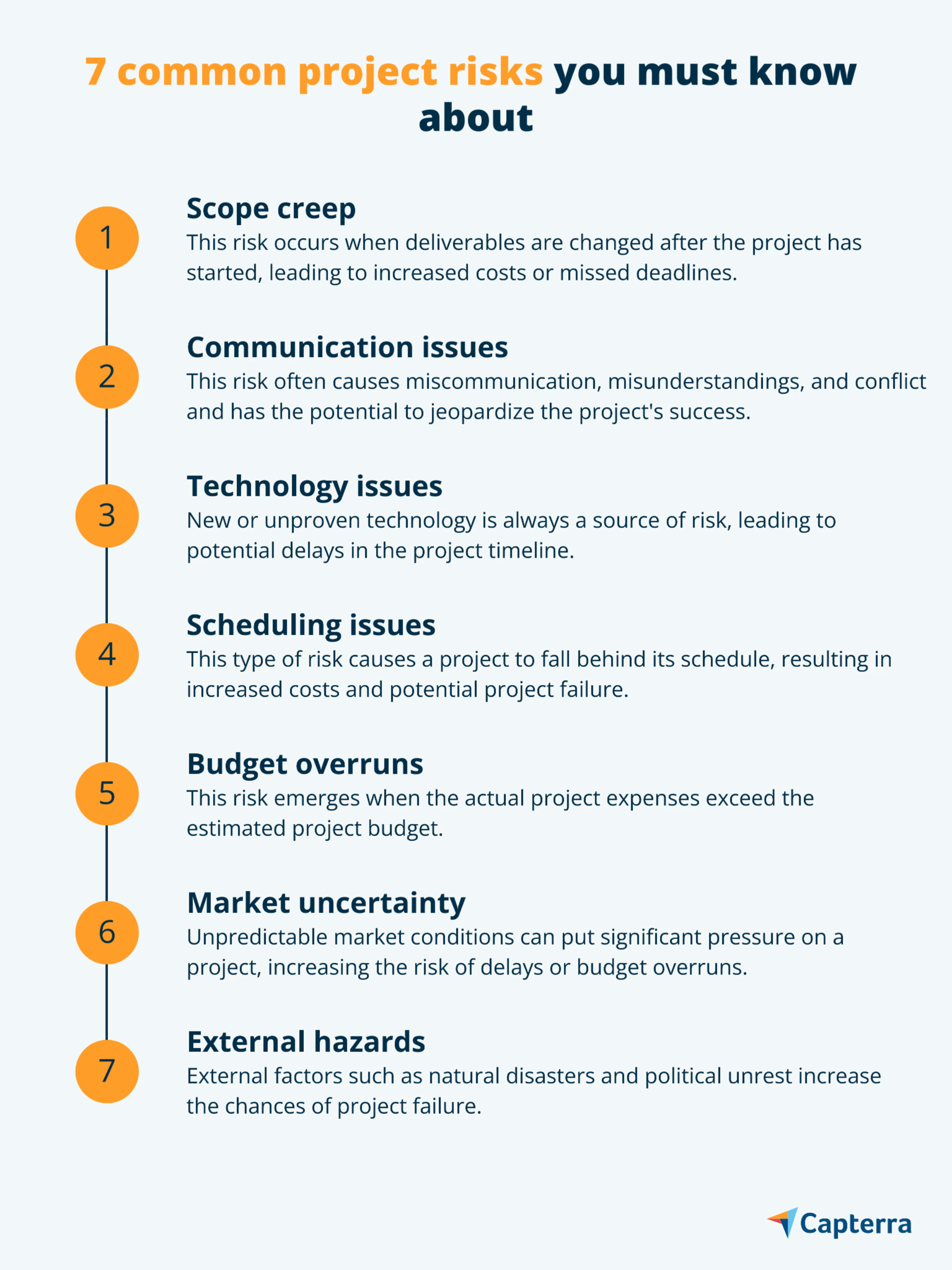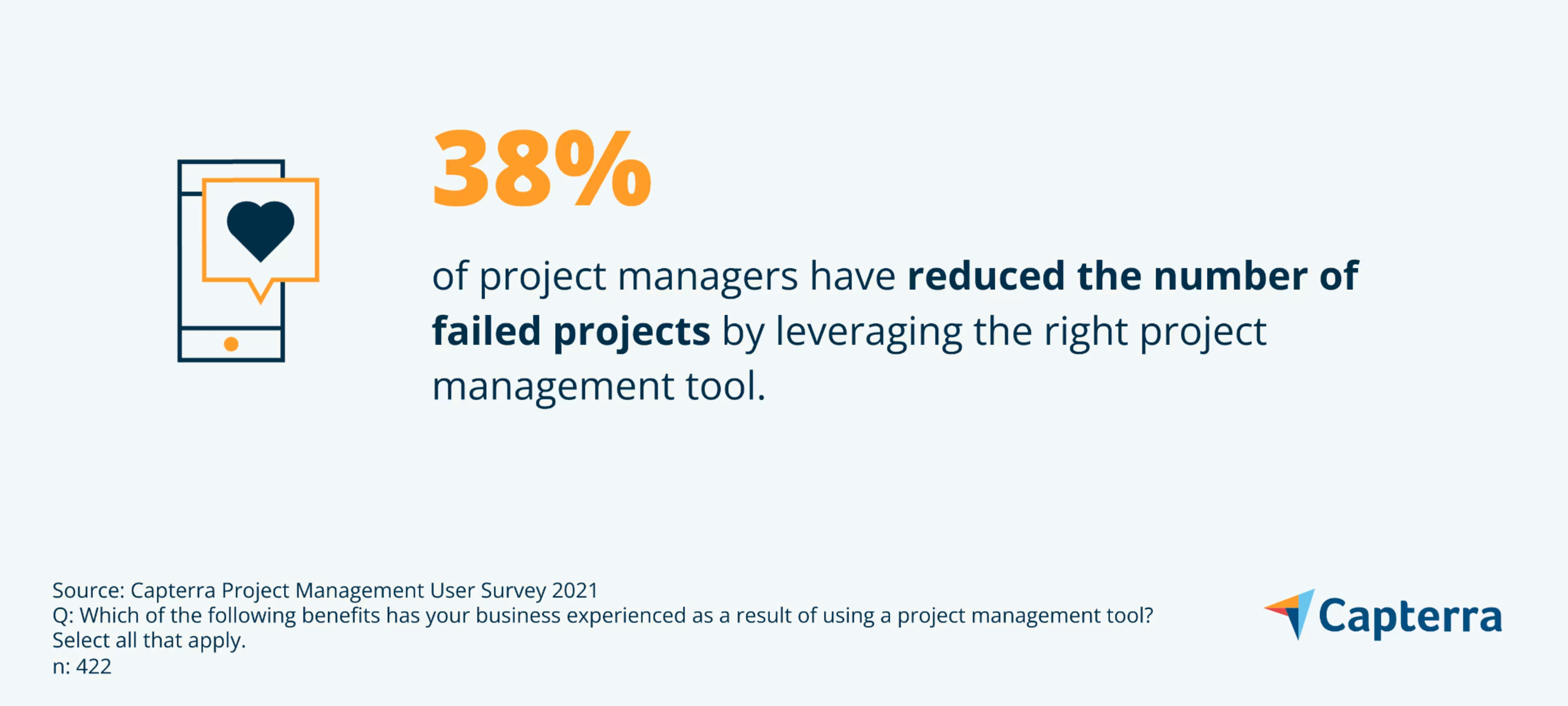Learn about the different types of project risks and ways to mitigate them.
Every project, no matter how well planned, has risks that can derail the project and cause setbacks. If not appropriately managed, these risks can also lead to loss of time, money, and customers.
That’s why companies today look for project managers who have the skill required to handle risk. As per Capterra’s Emotional Intelligence in the Workplace Survey, 52% of project managers agree that managing risk is an integral part of their job performance and is included in their annual review. (See the survey methodology here.)
If you’re a project manager responsible for delivering projects on time, you should know about the different types of project risks and how to mitigate them. This blog lists seven common project risks and some proven ways to prevent them. Read on to learn more.
What is project risk?
Project risk is any event that has the potential to endanger a project’s outcome or success. It can be anything that can cause your project to not meet its objectives. Technical issues, scheduling delays, and budget overruns are some examples.
Project risks can have severe consequences—ranging from simple setbacks to complete project failure. If not managed properly, risks can become roadblocks, halting project progress and causing delays.

1. Scope creep
Scope creep is one of the most common risks associated with projects. It usually occurs when the project deliverables are changed after they have already been defined. This can happen for various reasons such as budget constraints or new requirements added by stakeholders. Scope creep often causes project delays and cost overruns.
how to mitigate scope creep
Develop a clear, concise project scope at the start of the project by identifying all deliverables and objectives.
Get buy-in from all stakeholders and have them sign off on the project scope.
Set up a change management process to control changes to the project scope by evaluating their likely impact.
Detect scope creep early on by monitoring the project closely and comparing actual progress to planned progress.
Read more:3 Tips To Manage Scope Creep for Your Projects
2. Communication issues
This risk occurs when there’s a breakdown in communication between the project team and stakeholders. For instance, the project team may not understand the needs of stakeholders, or the stakeholders may not be up to date with the project’s progress. It can lead to miscommunication or misunderstandings, increasing the chances of project failure.
how to mitigate communication risk
Create a communication plan that clearly outlines how and when stakeholders will be updated on the project’s progress.
Ensure all project team members understand their roles and responsibilities in terms of communication.
Conduct regular meetings with team members and stakeholders to avoid communication gaps and ensure everyone is on the same page.
Encourage open communication by creating an environment where people feel comfortable asking questions or raising concerns.
Check out Capterra's Shortlist of the best team communication software to ensure smooth and effective communication throughout the project lifecycle.
3. Technology issues
As you may have already guessed, these risks emerge when there’s a problem with the technology used for a project. It can be anything—from outdated software and incompatible hardware to system integration or compatibility issues. Technology risks can stall project progress or even lead to complete failure.
how to mitigate technology risk
At the start of the project, conduct a feasibility study to check if the chosen technology is appropriate for the project and will not cause any technical difficulties.
Train project team members on how to use the selected technology. Also, ensure they understand its limitations.
Have a backup plan or alternative technology tools in case your selected technology fails or doesn’t work as intended.
Monitor the project closely for any signs of technology issues and troubleshoot them immediately.

Check out Capterra's Shortlist of the best project management software to streamline project execution.
4. Scheduling issues
Scheduling risk usually occurs when the project timeline is not realistic or when there are delays in the project schedule. For example, the project team may miscalculate the time required to complete the project, or unforeseen circumstances such as technology issues or scope creep may cause delays.
how to mitigate scheduling risk
Create a realistic project schedule by accurately estimating the time required for each task and adding a buffer for unforeseen circumstances.
Communicate any changes in the project schedule to all stakeholders in advance.
Be flexible with the project schedule, and be willing to make changes if necessary.
Monitor the project progress regularly, and update the schedule accordingly to avoid falling behind.
Check out Capeterra's Shortlist of the best task management software to ensure effective project scheduling.
5. Budget overruns
Budget overruns, another common project risk, occur when actual project expenses exceed the estimated project budget. Budget overruns can be due to various reasons. The project team, for instance, may underestimate the cost of materials, or unexpected expenses may arise during the course of the project.
how to mitigate budget overruns
Create a realistic budget by accurately estimating the cost of all materials and labor.
Communicate any changes in the project budget to all stakeholders in advance.
Be flexible with the project budget and be willing to make changes if necessary.
Monitor the project progress regularly, and update the budget plan accordingly to avoid overspending.
Check out Capterra's Shortlist of the best budgeting software to allocate, track, and manage project budgets without any hassles.
6. Market uncertainty
Market uncertainty is any unprecedented market risk that can occur during the course of a project. This happens when uncertainty in market or economic conditions impacts the project outcome. For example, a change in government regulations or a drop in customer demand could lead to project delays or even cancellation.
how to mitigate market uncertainty
Before starting a project, conduct in-depth market research to understand current market trends and conditions.
Be flexible with the project plan, and be willing to make changes if necessary.
Follow the market closely for political, economical, societal, or any other changes that may impact the project.
Develop a contingency plan in case market conditions change unexpectedly
7. External hazards
External hazards are those risks that come from outside your company and are out of the project team’s control. They include things like natural disasters, political instability, or even a pandemic. You can't predict or prevent these types of events. External risks can cause severe damage to a project and may even lead to its failure.
how to mitigate external risks
Conduct a risk assessment to identify potential hazards that could impact the project.
Develop a contingency plan to manage potential external hazards and ensure all stakeholders are aware of the plan.
Monitor the project closely for any signs of potential hazards, and take action immediately to avoid damage.
Project risk mitigation advice from industry professionals
We spoke to a few industry professionals to learn more about the project risks they frequently encounter and what they do to mitigate them to ensure project success.
Kevin Daly, head of marketing at Zevo Health, shares how he and his team manage project risks.
People who communicate risk less and accomplish more.


Kevin Daly
Head of marketing at Zevo Health
We've worked on projects where our client was flaky and didn't stick to their deadlines, or where we had to deal with a difficult source of materials. We've also seen situations where the team members lacked the necessary skills to complete a few niche-specific projects.
In all cases, our solution has been the same—i.e., communication.
We make sure that each member of our team is aware of their responsibilities, what's going on in the project, and how they can help everyone else succeed. This means that if one person runs into difficulty with their assigned job, they may simply communicate it and get help from anyone on the team who has more expertise—and vice versa. So far, this strategy has worked for us every time!
Josh Nelson, CEO of Seven Figure Agency, talks about the lack of clarity, how it affects the entire project, and how he manages this type of risk.
A clear, shared vision usually helps the team avoid project issues and stay motivated to achieve project success.


Josh Nelson
CEO of Seven Figure Agency
Most people have had the regrettable experience of investing a significant amount of time into a project only to discover that they misinterpreted the request. Poor communication between clients and stakeholders is to be blamed, often leading to scope creep.
Clearly defining the project objective and what is expected from the end result can help mitigate this type of risk. Be an effective communicator and a good lister to obtain clarification from clients on what they need and want. Ask as many questions as necessary to gain a clear picture of the requirements and the intended use.
Tips to identify potential project risks early on
It's important to know how to identify project risks early on to mitigate their effects. Here are a few risk identification techniques for you to try:
Conduct a risk assessment. This process helps identify and assess risks that could potentially impact the outcome of your projects.
Monitor the project closely. This involves keeping track of the project progress and looking for any red flags or warning signs that could indicate a potential risk.
Monitor changes in the market. This involves keeping up with current market conditions and trends to identify their likely impact on the project.
Communicate with stakeholders. This involves regularly communicating with all project stakeholders to avoid misunderstandings and have everyone on the same page.
Be flexible: This means being open or willing to make changes to the project plan, if necessary, to avoid potential risk factors.
There’s another proven way to identify and manage risks early on—using risk management software. Check out the pros and cons of using risk management software for your projects.
Watch this video to make an informed decision.

